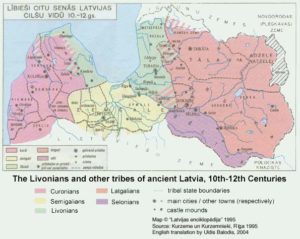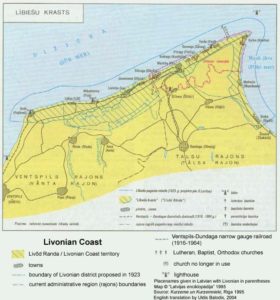
The Livonians are a Finnic nation native to Latvia. Historically, they have inhabited a region of varying extent along the coasts of the Baltic Sea and Gulf of Rīga in Latvia and even deeper into Latvia along the Daugava River. With the passage of time, the region in which Livonian was spoken continued to shrink. By approximately the 1860s, Livonian ceased to be spoken on the eastern shore of the Gulf of Rīga (the last known speakers of Livonian in this region lived near the town of Svētciems). In the 20th century, prior to WWII, the Livonians lived in a string of villages in northern Kurzeme in extreme northwestern Latvia. During this time Livonian was still a language used in daily life by members of all generations.
The term “Livonia” is confusing in English, as it refers to a region and historical administrative unit, which is not specifically related to the Livonians. (The Wikipedia article on this historical “Livonia” gives a fairly good overview of its history.) The term “Livonia” is also used in the name of this website as a convenient way to talk about the place where the Livonians live; however, in general “Livonia” is not used in English to refer to the Livonians’ homeland.
During the Soviet occupation of Latvia following WWII, the coast historically inhabited by the Livonians was militarized by the Soviets, which made it difficult for civilians to live in this area. As a result most Livonians ultimately left their ancestral villages and moved to larger cities including Rīga and Kolka. During WWII, some Livonians also fled Latvia and ended up living as part of the Latvian refugee community in various Western countries, including Sweden, the United States, Canada, and elsewhere. The last known native speaker of Livonian, Grizelda Kristiņa, was a member of this community and lived near Toronto, Canada until her passing in 2013.

The Livonians have never had a state or region of their own in modern times. During the pre-WWII independence of Latvia, the Livonians became more organized and worked to secure a role for their language in their communities with the publication of the Livonian-language newspaper “Līvli”, the holding of religious services in Livonian on the Livonian Coast, and the teaching of Livonian in village schools to a limited extent. During this same time, the Livonians petitioned the Latvian government for the creation of their own Livonian administrative region, which would encompass all of their villages. This was ultimately unsuccessful. Following the Soviet occupation, with the militarization of the Livonian native region, no further movement on such a project was possible.
Between 1990 and 1991, Latvia successfully reestablished its pre-WWII independence. On February 4, 1991, a special territory named “Līvõd Rānda” (“Livonian Coast”, in Livonian) was created with the intent of working to preserve, protect, and renew the Livonian cultural and linguistic identity of the coast. This territory existed until 2003. Since that time and up until the present (as of 2017), there has not existed and does not exist any specifically Livonian territorial unit in Latvia, nor are there any plans for the creation of such a unit.